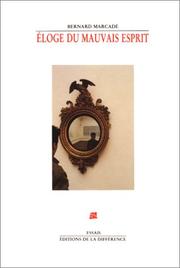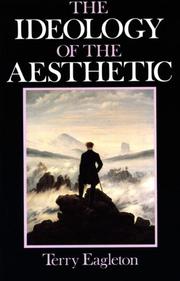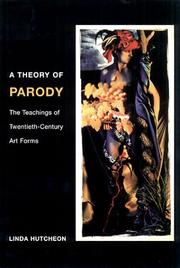| Listing 1 - 10 of 39 | << page >> |
Sort by
|

ISBN: 272910223X 9782729102234 Year: 1986 Publisher: Paris : Editions de la Différence,
Abstract | Keywords | Export | Availability | Bookmark
 Loading...
Loading...Choose an application
- Reference Manager
- EndNote
- RefWorks (Direct export to RefWorks)
Book
ISBN: 9782718606620 2718606622 Year: 2004 Publisher: Paris : Galilée,
Abstract | Keywords | Export | Availability | Bookmark
 Loading...
Loading...Choose an application
- Reference Manager
- EndNote
- RefWorks (Direct export to RefWorks)
On accusait hier l'esthétique de dissimuler les jeux culturels de la distinction sociale. On voudrait aujourd'hui délivrer les pratiques artistiques de son discours parasite. Mais l'esthétique n'est pas un discours. C'est un régime historique d'identification de l'art. Ce régime est paradoxal, car il ne fonde l'autonomie de l'art qu'au prix de supprimer les frontières séparant ses pratiques et ses objets de ceux de la vie ordinaire et de faire du libre jeu esthétique la promesse d'une révolution nouvelle. L'esthétique n'est pas politique par accident mais par essence. Mais elle l'est dans la tension irrésolue entre deux politiques opposées: transformer les formes de l'art en formes de le vie collective, préserver de toute compromission militante ou marchande l'autonomie qui en fait une promesse d'émancipation. Cette tension constitutive explique les paradoxes et les transformations de l'art critique. Elle permet aussi de comprendre comment les appels à libérer l'art de l'esthétique conduisent aujourd'hui à le noyer, avec la politique dans l'indistinction éthique.
Multi
ISBN: 9781107643222 9781107038035 9781107038042 9781107038059 1107643228 1107038030 1107038049 1107038057 9781107110342 1107110343 Year: 2014 Publisher: New York, N.Y. Cambridge University Press
Abstract | Keywords | Export | Availability | Bookmark
 Loading...
Loading...Choose an application
- Reference Manager
- EndNote
- RefWorks (Direct export to RefWorks)
A History of Modern Aesthetics narrates the history of philosophical aesthetics from the beginning of the eighteenth century through the twentieth century. Aesthetics began with Aristotle's defense of the cognitive value of tragedy in response to Plato's famous attack on the arts in The Republic, and cognitivist accounts of aesthetic experience have been central to the field ever since. But in the eighteenth century, two new ideas were introduced: that aesthetic experience is important because of emotional impact - precisely what Plato criticized - and because it is a pleasurable free play of many or all of our mental powers. This book tells how these ideas have been synthesized or separated by both the best-known and lesser-known aestheticians of modern times, focusing on Britain, France and Germany in the eighteenth century; Germany and Britain in the nineteenth; and Germany, Britain and the United States in the twentieth.
Aesthetics --- anno 1700-1799 --- anno 1800-1999 --- Aesthetics, Modern --- Aesthetics, Modern. --- PHILOSOPHY --- History. --- History & Surveys --- Modern. --- Modern aesthetics --- History --- Philosophy
Book
ISBN: 9781472421722 1138247715 9781138247710 9781315568287 9781317177470 9781317177487 1472421728 Year: 2016 Publisher: London Routledge, Taylor & Francis Group
Abstract | Keywords | Export | Availability | Bookmark
 Loading...
Loading...Choose an application
- Reference Manager
- EndNote
- RefWorks (Direct export to RefWorks)
Originally published in Italian in 2010, this book is the first to address the theory of atmospheres in a thorough and systematic way. It examines the role of atmospheres in daily life, and defines their main characteristics. Outlining the typical phenomenological situations in which we experience atmospheres, it assesses their impact on contemporary aesthetics. It puts forward a philosophical approach which systematises a constellation of affects and climates, finds patterns in the emotional tones of different spaces (affordances) and assesses their impact on the felt body. It also critically discusses the spatial turn invoked by several of the social sciences, and argues that there is a need for a non-psychologistic rethinking of the philosophy of emotions. It provides a history of the term 'atmosphere' and of the concepts anticipating its meaning (genius loci, aura, Stimmung, numinous, emotional design and ambiance), and examines the main ontological characteristics of atmospheres and their principal phenomenological characteristics. It concludes by showing how atmospheres affect our emotions, our bodies' reactions, our state of mind and, as a result, our behaviour and judgments. Griffero assesses how atmospheres are more effective than we have been rationally willing to admit, and to what extent traditional aesthetics, unilaterally oriented towards art, has underestimated this truth.
Philosophical anthropology --- Aesthetics --- Affective and dynamic functions --- Architecture --- Criticism --- Social aspects --- Space. --- Aesthetics, Modern. --- Emotions (Philosophy) --- Espace --- Esthétique --- Emotions (Philosophie) --- Space --- Mood (Psychology) --- Aesthetics, Modern
Book
ISBN: 9789054879329 Year: 2011 Publisher: Brussel VUBPress
Abstract | Keywords | Export | Availability | Bookmark
 Loading...
Loading...Choose an application
- Reference Manager
- EndNote
- RefWorks (Direct export to RefWorks)
Art --- Philosophy --- Aesthetics [Modern ] --- 21st century --- MAD-faculty 16 --- kunst en filosofie
Book
ISBN: 8886490127 Year: 1995 Publisher: Roma : Carte segrete,
Abstract | Keywords | Export | Availability | Bookmark
 Loading...
Loading...Choose an application
- Reference Manager
- EndNote
- RefWorks (Direct export to RefWorks)
I saggi qui raccolti, quando non specificamente indicato, sono una parziale rielaborazione degli interventi ospitati nel ciclo di incontri Arte Identità Confini svoltosi dal 26 febbraio al 19 marzo 1995 al Palazzo della Esposizioni di Roma, realizzato dall'Assessorato alla Cultura del Comune di Roma in collaborazione con Zerynthia Associazione per l'arte contemporanea. Series of meetings with performances, lectures, video and exhibition. Abramovic, Marina ; Araeen, Rasheed ; Bagnoli, Marco ; Doherty, Willie ; Durham, Jimmie ; Esposito, Bruna ; Galeotti, Roberto ; Green, Renée ; Hatoum, Mona ; Lebel, Jean-Jacques ; Mauri, Fabio ; Muntadas, Antoni ; Nitsch, Hermann ; Pistoletto, Michelangelo ; Prini, Emilio ; Sforza, Francesco ; Staehle, Wolfgang ; Strano Network ; Toderi, Grazia ; Tozzi, Tommaso ; Valentino, Nicola ; Vercruysse, Jan ; Vitone, Luca ; Zevi, Adachiara
Art, Modern --- Aesthetics, Modern --- Art --- Esthétique moderne --- Congresses. --- Congrès --- Esthétique moderne --- Congrès
Book
ISBN: 3770111257 Year: 1979 Publisher: Köln DuMont
Abstract | Keywords | Export | Availability | Bookmark
 Loading...
Loading...Choose an application
- Reference Manager
- EndNote
- RefWorks (Direct export to RefWorks)
-German arts --- -Moderne kunststijlen --- -7.036 --- -7.036 Moderne kunststijlen --- Aesthetics, Modern --- Arts, Modern --- -Arts, German --- Modern arts --- 7.036 Moderne kunststijlen --- Moderne kunststijlen --- -Aesthetics, Modern --- Arts, German --- 7.036 --- Aesthetics --- History --- Art styles --- anno 1920-1929 --- Germany --- Duitsland

ISBN: 0631163026 0631163018 9780631163015 9780631163022 Year: 1991 Publisher: Oxford Blackwell
Abstract | Keywords | Export | Availability | Bookmark
 Loading...
Loading...Choose an application
- Reference Manager
- EndNote
- RefWorks (Direct export to RefWorks)
The Ideology of the Aesthetic presents a history and critique of the concept of the aesthetic throughout modern Western thought. As such, this is a critical survey of modern Western philosophy, focusing in particular on the complex relations between aesthetics, ethics and politics. Eagleton provides a brilliant and challenging introduction to these concerns, as characterized in the work of Kant, Schiller, Schopenhauer, Kierkegaard, Marx, Nietzsche, Freud, Heidegger, Lukacs, Adorno, Habermas, and others. Wide in span, as well as morally and politically committed, this is Terry Eagleton's major work to date. It forms both an original enquiry and an exemplary introduction. (4 ème de couverture)
Aesthetics [Modern ] --- Esthetica (Moderne filosofie) --- Esthetica [Moderne ] --- Esthétique (Philosophie moderne) --- Esthétique moderne --- Modern aesthetics --- Moderne esthetica --- Aesthetics, Modern. --- #A9302PC --- Esthétique moderne --- Aesthetics, Modern --- 7.01 --- 7.01 Esthetica. Kunstfilosofie. Kunsttheorie. Algemene problemen inzake kunst --- Esthetica. Kunstfilosofie. Kunsttheorie. Algemene problemen inzake kunst --- Aesthetics --- Art --- Esthétique --- Philosophie --- Philosophie de l'art --- CDL

ISBN: 0941920100 1565844610 9781565844612 9780941920100 Year: 1988 Volume: Number 2 Publisher: Seattle Bay Press
Abstract | Keywords | Export | Availability | Bookmark
 Loading...
Loading...Choose an application
- Reference Manager
- EndNote
- RefWorks (Direct export to RefWorks)
Aesthetics, Modern. --- Aesthetics. --- Art and society. --- Aesthetics of art --- Art --- Contemporary [style of art] --- Art and society --- Aesthetics, Modern --- Esthétique --- Philosophy. --- Aspect social. --- Visual perception --- Visual Perception --- CDL --- 7.01 --- Vision, Ocular --- Visual Processing --- Perception, Visual --- Processing, Visual --- Perception --- Vision --- Visual discrimination --- Optics, Psychological --- Aesthetics --- Art and sociology --- Society and art --- Sociology and art --- Psychological aspects --- History --- Social aspects --- Kongress --- Aesthetics, Modern - 20th century

ISBN: 0252069382 9780252069383 Year: 2000 Publisher: Urbana University of Illinois press
Abstract | Keywords | Export | Availability | Bookmark
 Loading...
Loading...Choose an application
- Reference Manager
- EndNote
- RefWorks (Direct export to RefWorks)
In this major study of a flexible and multifaceted mode of expression, Linda Hutcheon looks at works of modern literature, visual art, music, film, theater, and architecture to arrive at a comprehensive assessment of what parody is and what it does. Hutcheon identifies parody as one of the major forms of modern self-reflexivity, one that marks the intersection of invention and critique and offers an important mode of coming to terms with the texts and discourses of the past. Looking at works as diverse as Tom Stoppard's Rosenkrantz and Guildenstern Are Dead, Brian de Palma's Dressed to Kill, Woody Allen's Zelig, Karlheinz Stockhausen's Hymnen, James Joyce's Ulysses, and Magritte's This Is Not a Pipe, Hutcheon discusses the remarkable range of intent in modern parody while distinguishing it from pastiche, burlesque, travesty, and satire. She shows how parody, through ironic playing with multiple conventions, combines creative expression with critical commentary. Its productive-creative approach to tradition results in a modern recoding that establishes difference at the heart of similarity. In a new introduction, Hutcheon discusses why parody continues to fascinate her and why it is commonly viewed as suspect--for being either too ideologically shifty or too much of a threat to the ownership of intellectual and creative property.
Parody in art. --- Aesthetics, Modern --- Arts, Modern --- 82-7 --- 82.01 --- -Parody in art --- Modern arts --- Humor. Satire --- Esthetica --- -82-7 --- 82.01 Esthetica --- 82-7 Humor. Satire --- -Parody in art. --- -Aesthetics, Modern --- Parody in art --- Aesthetics --- History --- 82-7 Prose satire. Humour, epigram, parody etc. --- Prose satire. Humour, epigram, parody etc. --- Aesthetics, Modern - 20th century. --- Arts, Modern - 20th century. --- Forme (esthétique) --- Art --- Littérature --- Parodie (art) --- Esthétique --- Arts --- 20e siècle --- Thèmes, motifs
| Listing 1 - 10 of 39 | << page >> |
Sort by
|

 Search
Search Feedback
Feedback About UniCat
About UniCat  Help
Help News
News